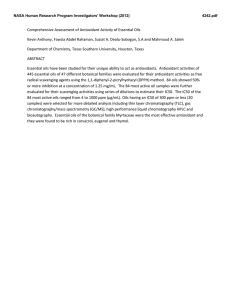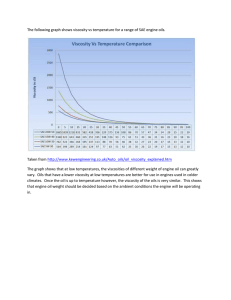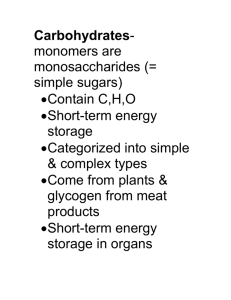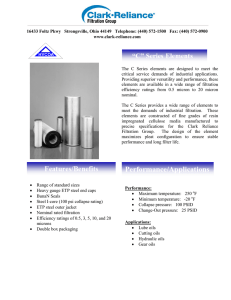Tocopherol content in edible plant oils
advertisement
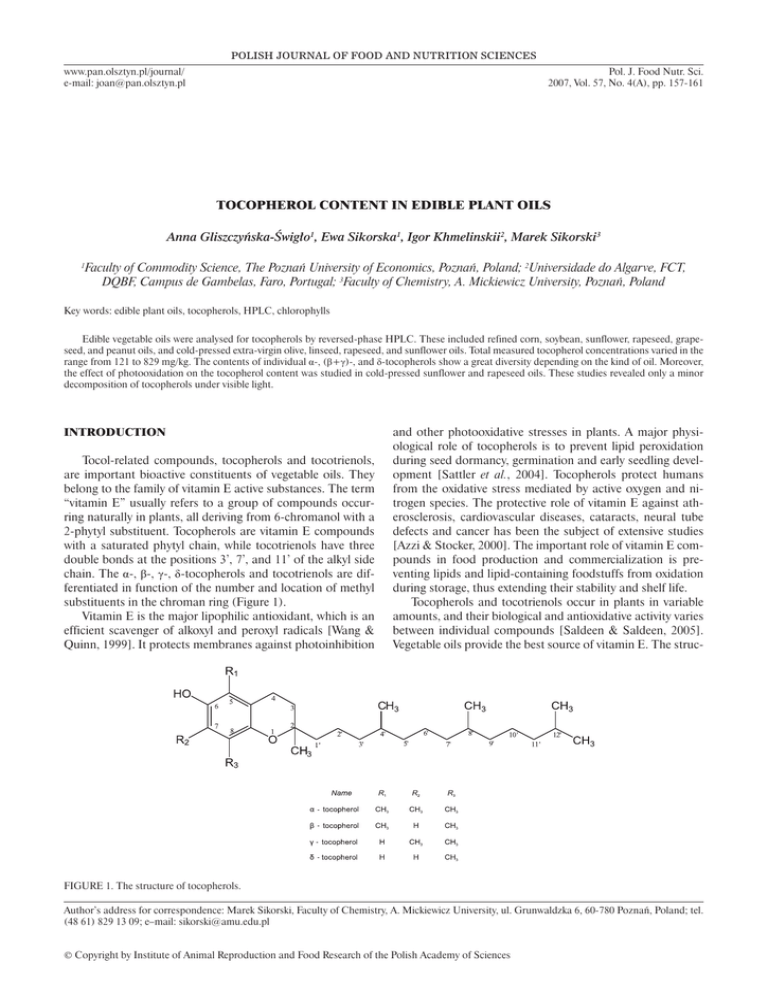
polish journal of food and nutrition sciences www.pan.olsztyn.pl/journal/ e-mail: joan@pan.olsztyn.pl Pol. J. Food Nutr. Sci. 2007, Vol. 57, No. 4(A), pp. 157-161 TOCOPHEROL CONTENT IN EDIBLE PLANT OILS Anna Gliszczyńska-Świgło1, Ewa Sikorska1, Igor Khmelinskii2, Marek Sikorski3 Faculty of Commodity Science, The Poznań University of Economics, Poznań, Poland; 2Universidade do Algarve, FCT, DQBF, Campus de Gambelas, Faro, Portugal; 3Faculty of Chemistry, A. Mickiewicz University, Poznań, Poland 1 Key words: edible plant oils, tocopherols, HPLC, chlorophylls Edible vegetable oils were analysed for tocopherols by reversed-phase HPLC. These included refined corn, soybean, sunflower, rapeseed, grapeseed, and peanut oils, and cold-pressed extra-virgin olive, linseed, rapeseed, and sunflower oils. Total measured tocopherol concentrations varied in the range from 121 to 829 mg/kg. The contents of individual α-, (β+γ)-, and δ-tocopherols show a great diversity depending on the kind of oil. Moreover, the effect of photooxidation on the tocopherol content was studied in cold-pressed sunflower and rapeseed oils. These studies revealed only a minor decomposition of tocopherols under visible light. INTRODUCTION Tocol-related compounds, tocopherols and tocotrienols, are important bioactive constituents of vegetable oils. They belong to the family of vitamin E active substances. The term “vitamin E” usually refers to a group of compounds occurring naturally in plants, all deriving from 6-chromanol with a 2-phytyl substituent. Tocopherols are vitamin E compounds with a saturated phytyl chain, while tocotrienols have three double bonds at the positions 3’, 7’, and 11’ of the alkyl side chain. The α-, β-, γ-, δ-tocopherols and tocotrienols are differentiated in function of the number and location of methyl substituents in the chroman ring (Figure 1). Vitamin E is the major lipophilic antioxidant, which is an efficient scavenger of alkoxyl and peroxyl radicals [Wang & Quinn, 1999]. It protects membranes against photoinhibition and other photooxidative stresses in plants. A major physiological role of tocopherols is to prevent lipid peroxidation during seed dormancy, germination and early seedling development [Sattler et al., 2004]. Tocopherols protect humans from the oxidative stress mediated by active oxygen and nitrogen species. The protective role of vitamin E against atherosclerosis, cardiovascular diseases, cataracts, neural tube defects and cancer has been the subject of extensive studies [Azzi & Stocker, 2000]. The important role of vitamin E compounds in food production and commercialization is preventing lipids and lipid-containing foodstuffs from oxidation during storage, thus extending their stability and shelf life. Tocopherols and tocotrienols occur in plants in variable amounts, and their biological and antioxidative activity varies between individual compounds [Saldeen & Saldeen, 2005]. Vegetable oils provide the best source of vitamin E. The struc- Figure 1. The structure of tocopherols. Author’s address for correspondence: Marek Sikorski, Faculty of Chemistry, A. Mickiewicz University, ul. Grunwaldzka 6, 60-780 Poznań, Poland; tel. (48 61) 829 13 09; e–mail: sikorski@amu.edu.pl © Copyright by Institute of Animal Reproduction and Food Research of the Polish Academy of Sciences 158 A. Gliszczyńska-Świgło et al. tural complexity and the wide variation in activity of these compounds necessitate reliable analytical techniques for quantification of individual components in mixtures originating from various sample matrices. A variety of methods had been described for determination of vitamin E homologues and isomers, using both normal-phase and reversed-phase high-performance liquid chromatography (HPLC) [Abidi, 2000; Ruperez et al., 2001]. The aim of the present study was to determine tocopherol contents in several edible plant oils available on the Polish market. Moreover, the effect of photooxidation on the tocopherol content was investigated for selected cold-pressed oils. MATERIAL AND METHODS Materials. The studies were performed on commercially available edible oils acquired in a local supermarket. Three to four bottles of each olive, grapeseed, rapeseed, soybean, sunflower, peanut, and corn oils were analysed, the replicate bottles contained the same brand of oil. For cold-pressed sunflower, rapeseed and linseed oils, only one bottle was analysed. α-Tocopherol (97%) and 2-propanol were purchased from Aldrich (Steinheim, Germany), γ- and δ-tocopherols were from Sigma (St. Louis, USA) and were used as received. Irradiation experiments. The irradiation experiments on cold-pressed sunflower and rapeseed oils were performed using a home-built carousel device in a thermostatic water bath at 20°C. The oils were sealed in 1 cm i.d. Pyrex test tubes, placed in a rotating holder and exposed to the radiation of a single type Q 81 Original Hanau (81 W) high-pressure mercury lamp through the total 3 mm of Pyrex glass. The maximum irradiation time was 2 h. HPLC analysis. The analysis of tocopherol content was performed with a HPLC method described in detail in reference [Gliszczynska-Swiglo & Sikorska, 2004]. Briefly, the analysis was executed at room temperature on a Waters 600 high performance liquid chromatograph equipped with a Symmetry C18 column (150 mm×3.9 mm, 5 μm) fitted with a μBondapak C18 cartridge guard column (all from Waters, Millford, Ma, USA). Mobile phase of acetonitrile and methanol (1:1, v/v) was used at the flow rate of 1 mL/min. Samples of oils were weighted (0.0400-0.1200 g) and dissolved in 1 mL of 2-propanol. Vortex-mixed samples were directly injected onto the HPLC column without any additional sample treatment. Injection volume was 20 μL; rheodyne-type injector was used. The eluate was detected using a Waters 474 scanning fluorescence detector set for the emission at 325 nm and excitation at 295 nm. Emission slit width was 10 nm, fluorometer gain 100, and attenuation 1. Tocopherols were identified by comparing their retention times with those of the corresponding standards and by spiking the samples with an appropriate standard. Additionally, a Waters 996 photodiodearray detector was used to identify the compounds by their absorption spectra. RESULTS AND DISCUSSION The content of tocopherols in oils The content of individual and total tocopherols in analysed oils is reported in Table 1. The total tocopherol content ranges from 121 mg/kg in grapeseed oil to 829 mg/kg in corn and soybean oil. The results show a wide variability in the content and distribution of tocopherols in various oils. Interestingly, cold-pressed sunflower and rapeseed oils have tocopherol concentrations similar to those in the respective refined oils tested in his study. It is known that natural tocopherols are retained at considerable levels in refined vegetable oils because of their relatively high thermal resistance. As a rule, only modest tocopherol losses occur during deodorization and distillation phases of edible oil processing. α-Tocopherol dominates in olive, grapeseed and sunflower oils. (β + γ)Tocopherols dominate in corn, soybean and rapeseed oils. According to the previous publications, β-tocopherol does not occur in plant oils or is found in negligibly low quantities, raging from 0 to 2.80 mg/100 g, depending on oil [Crawley, 1993; Gregory III, 1996]. Therefore, the fraction of (β + γ)tocopherols is in fact dominated by γ-tocopherol, and lack of separation does not introduce a significant error into the quantification of this compound. Peanut oil contains similar Table 1. Tocopherol content of plant oils as determined by HPLC (mg/kg). Oil Corn Grapeseed Characteristic α (β+γ) δ Total Tocopherol* refined 207±11 592±20 30.0±1.0 829±23 refined 103±5 15.0±4.0 3.4±1.6 121±6 cold-pressed - 363±7 5.2±0.8 367±8 extra virgin 163±3 12.3±0.4 1.6±0.3 177±3 refined 102±3 112±2 12.0±0.1 226±4 Rapeseed refined 178±25 281±13 12.0±2.0 468±28 Rapeseed cold-pressed 181±5 244±7 9.3±0.1 434±9 Soybean refined 152±1 494±12 182±3 829±12 Sunflower refined 575±11 25.2±0.4 8.8±0.4 609±11 Sunflower cold-pressed 490±8 30.8±0.5 10.1±0.1 535±8 Linseed Olive Peanut *Mean values of total tocopherol content together with standard deviations. For refined and extra virgin olive oil, four samples from three or four separate bottles of the each kind of oil were analysed, for cold-pressed oils samples from one bottle of oil were analysed in four replicates. Tocopherol content in oils amounts of α- and (β+γ)-tocopherols, whereas soybean oil contains similar amounts of α- and δ-tocopherols. The concentration of δ-tocopherol in all oils, with exception of soybean oil, never exceeds 30 mg/kg. Linseed oil is the only oil where α-tocopherol was not detected. The results obtained are in general agreement with the previously published data [Abidi, 2003; Chase et al., 1994; Lo Curto et al., 2001; Psomiadou & Tsimidou, 1998]. These results confirm that vegetable oils are major dietary sources of vitamin E [US Department of Agricultural Research Service, 2007; Azzi & Stocker, 2000]. The importance of determining not only the total tocopherol content but also the distribution of individual components is due to the increasingly recognized diversity in the functional properties of tocopherol isomers and homologues; some examples are discussed below. The presence of tocopherols contributes to oxidative stability of edible oils, which is considered to be one of the most important functional properties of oils. This property is especially important in fried or processed foods using vegetable oils. The experiments showed that the stability of different tocopherols and tocotrienols present in the refined vegetable oils depend on the kind of tocopherol derivatives and the fatty acid composition of the oil, in particular on polyunsaturated fatty acid content [Rossi et al., 2007]. It was shown that different forms of tocopherols differently contribute to the reduction of fatty acid oxidation and the formation of the off-flavour compounds such as hexanals, with γ- and δ-tocopherols exhibiting the highest efficiency in reducing the oxidative breakdown of vegetable oils in frying applications [Wagner et al., 2001; Wagner & Elmadfa, 2000; Warner et al., 2003]. α-Tocopherol is considered to have the highest nutritional value of all the different forms of tocopherols. On the other hand, studies revealed that various forms of tocochromanols exhibit diverse health-promoting properties [Saldeen & Saldeen, 2005]. Thus, the lack of natural tocopherols, such as γ- and δ-tocopherols, in most of the vitamin E preparations, may be a limiting factor for promoting health. In contrast to α-tocopherol, γ-tocopherol has specific biologic activity that potentially protects against chronic diseases, such as inflammation. Evidence indicates that mixed tocopherols found in native vegetable oils afford additive and synergetic activities that support their broader beneficial biologic functions. Both γ- and δ-tocopherols may be necessary for preventing lipid peroxidation and in counteracting the prooxidant effect of α-tocopherol. Moreover, all tocopherols, except β-tocopherol, inhibit smooth muscle proliferation [Saldeen & Saldeen, 2005]. Effect of photooxidation on tocopherol content in cold-pressed sunflower and rapeseed oils Cold-pressed plant oils, in contrast to refined oils, may contain pigments of the chlorophyll group, which are known photosensitisers. These chemical species absorb light and activate molecular oxygen to induce photosensitised oxidation via singlet oxygen (1O2) formation [Min & Boff, 2002]. Cold-pressed oils are therefore more susceptible to photooxidation then refined oils, as the latter contain none or very low amounts of chlorophylls, which are destroyed during oil processing. Note that oils are often packed in colourless 159 Figure 2. Changes in tocopherol and chlorophyll contents of sunflower oil upon irradiation. Concentrations are expressed as percentage of the initial content of the respective compound. bottles to fulfil consumer preferences. Such packing enables excitation of chlorophylls, which have strong absorption in the visible spectral region. Therefore, photoxidation becomes an important process contributing to oil deterioration. We have studied the effect of irradiation with visible light (wavelengths above 350 nm) on the tocopherol content in cold-pressed sunflower and rapeseed oils. Figure 2 shows the relative changes in the concentration of individual tocopherols and chlorophylls due to irradiation observed for cold-pressed sunflower oil. Similar effects were observed for cold-pressed rapeseed oil (data not shown). The changes are expressed in percentage of the initial concentration of a particular compound, corresponding to zero irradiation time. A rapid degradation of chlorophyll was observed already at the initial stages. On the contrary, only a rather minor decrease in tocopherols occurred even after 2 h of irradiation. The total tocopherol content was reduced by ca. 7% of the initial concentration for both oils studied. The extent of the concentration reduction varied for the individual tocopherol derivatives, following the order δ > α > (β + γ), and was similar for both oils. Tocopherols, which absorb in the ultraviolet region, can not be directly excited by visible light. Thus, the observed decrease in tocopherol concentration should result from their protective action against photochemical processes induced by other absorbing species present in oil. Indeed, tocopherols are known singlet oxygen quenchers. The extent to which tocopherols are destroyed in this process may be influenced by several factors, including: the concentration of sensitizers, the presence of other quenchers, and the quenching mechanism. Additionally, crude vegetable oils contain carotenoids, which exhibit the quenching rate constants almost two orders of magnitude higher than those of tocopherols. It had been found that tocopherol scavenges 1O2 by a combination of physical quenching and chemical reaction. As the physical quenching rate constant is much higher than that of the respective chemical process, the quenching is almost entirely physical. In effect, tocopherol deactivates singlet oxygen molecules before being consumed in a chemical reaction with 160 them [Mukai et al., 1991]. All these features may contribute to the rather low loss of tocopherols upon illumination. Recently, reactions of tocopherols with singlet oxygen in the presence of chlorophyll have been studied in a model system. It was found that singlet oxygen oxidation rate of tocopherols varied in the order α > γ > δ [Kim et al., 2006]. The differences in the relative reactivity of tocopherols as reported previously and in the present paper may be explained by differences existing between a model system and a real-world sample. These discrepancies encourage further studies of photoreactivity of various tocopherols in different edible oils. CONCLUSIONS Concentrations of α-, (β+γ)-, and δ-tocopherols were measured by HPLC in a series of cold-pressed and refined edible plant oils, with large variations observed in function of the kind of oil, stressing the advantage of consuming diverse vegetable oils as the source of natural tocopherols. Where possible, comparison of cold-pressed and refined oils confirmed that nutritionally beneficial tocopherols are largely preserved during the thermal treatment associated to the edible oil refining. Photooxidation tests run on selected cold-pressed oils, which are more susceptible to degradation due to larger concentrations of chlorophylls present, demonstrated that tocopherols are about an order of magnitude more stable than chlorophylls under visible light. REFERENCES 1. Abidi S.L., Chromatographic analysis of tocol-derived lipid antioxidants. J. Chromatogr. A, 2000, 881, 197-216. 2. Abidi S.L., Tocol-derived minor constituents in selected plant seed oils. J. Am. Oil Chemists Soc., 2003, 80, 327-333. 3. Azzi A., Stocker A., Vitamin E: non-antioxidant roles. Progr. Lipid Res., 2000, 39, 231-255. 4. Chase G.W., Akoh C.C., Eitenmiller R.R., Analysis of tocopherols in vegetable-oils by high-performance liquid-chromatography – comparison of fluorescence and evaporative light-scattering detection. J. Am. Oil Chemists Soc., 1994, 71, 877-880. 5. Crawley H., Natural occurrence of vitamins in food. 1993, in: The Technology of Vitamins in Food (ed. P.B. Ottaway). Blackie Academic & Professional, Glasgow, pp. 19-41. 6. Gliszczynska-Swiglo A., Sikorska E., Simple reversed-phase liquid chromatography method for determination of tocopherols in edible oils. J. Chromatogr. A, 2004, 1048, 195-198. 7. Gregory III J.F., Vitamins. 1996, in: Food Chemistry (ed. O.R. A. Gliszczyńska-Świgło et al. Fennema). Marcel Dekker, New York, pp. 531-616. 8. Kim H.J., Lee M.Y., Min D.B., Singlet oxygen oxidation rates of alpha-, gamma-, and delta-tocopherols. J. Food Sci., 2006, 71, C465-C468. 9. Lo Curto S., Dugo G., Mondello L., Errante G., Russo M.T., Variation in tocopherol content in Italian virgin olive oils. Ital. J. Food Sci., 2001, 13, 221-228. 10. Min D.B., Boff J.M., Chemistry and reaction of singlet oxygen in foods. Compr. Rev. Food Sci. Food Safety, 2002, 1, 58-72. 11. Mukai K., Daifuku K., Okabe K., Tanigaki T., Inoue K., Structure activity relationship in the quenching reaction of singlet oxygen by tocopherol (vitamin-E) derivatives and related phenols – finding of linear correlation between the rates of quenching of singlet oxygen and scavenging of peroxyl and phenoxyl radicals in solution. J. Org. Chem., 1991, 56, 4188-4192. 12. Psomiadou E., Tsimidou M., Simultaneous HPLC determination of tocopherols, carotenoids, and chlorophylls for monitoring their effect on virgin olive oil oxidation. J. Agric. Food Chem., 1998, 46, 5132-5138. 13. Rossi M., Alamprese C., Ratti S., Tocopherols and tocotrienols as free radical-scavengers in refined vegetable oils and their stability during deep-fat frying. Food Chem., 2007, 102, 812-817. 14. Ruperez F.J., Martin D., Herrera E., Barbas C., Chromatographic analysis of alpha-tocopherol and related compounds in various matrices. J. Chromatogr. A, 2001, 935, 45-69. 15. Saldeen K., Saldeen T., Importance of tocopherols beyond alpha-tocopherol: evidence from animal and human studies. Nutr. Res., 2005, 25, 877-889. 16. Sattler S.E., Gilliland L.U., Magallanes-Lundback M., Pollard M., DellaPenna D., Vitamin E is essential for seed longevity, and for preventing lipid peroxidation during germination. Plant Cell, 2004, 16, 1419-1432. 17. U.S. Department of Agriculture Agricultural Research Service, 2004.USDA National Nutrient Database for Standard Reference, Release 17.Nutrient Data Laboratory Home Page. [http: // www. nal. usda. gov/fnic/foodcomp], 2007. 18. Wagner K.H., Elmadfa I., Effects of tocopherols and their mixtures on the oxidative stability of olive oil and linseed oil under heating. Eur. J. Lipid Sci. Technol., 2000, 102, 624-629. 19. Wagner K.H., Wotruba F., Elmadfa I., Antioxidative potential of tocotrienols and tocopherols in coconut fat at different oxidation temperatures. Eur. J. Lipid Sci. Technol., 2001, 103, 746-751. 20. Wang X.Y., Quinn P.J., Vitamin E and its function in membranes. Progr. Lipid Res., 1999, 38, 309-336. 21. Warner K., Neff W.E., Eller F.J., Enhancing quality and oxidative stability of aged fried food with gamma-tocopherol. J. Agric. Food Chem., 2003, 51, 623-627. 161 Tocopherol content in oils ZAWARTOŚĆ TOKOFEROLI W JADALNYCH OLEJACH ROŚLINNYCH Anna Gliszczyńska-Świgło1, Ewa Sikorska1, Igor V. Khmelinskii2, Marek Sikorski3 Wydział Towaroznawstwa, Akademia Ekonomiczna, Poznań; 2Universidade do Algarve, FCT, Campus de Gambelas, Faro, Portugal; 3 Wydział Chemii, Uniwersytet im. A. Mickiewicza, Poznań 1 W pracy przedstawiono wyniki oznaczeń tokoferoli, metodą HPLC w odwróconym układzie faz, w olejach roślinnych, w tym w olejach rafinowanych (kukurydzianym, sojowym, słonecznikowym, rzepakowym, z pestek winogron, arachidowym) oraz tłoczonych na zimno (oliwie z oliwek, lnianym, rzepakowym i słonecznikowym). Wyznaczona całkowita zawartość tokoferoli (w zakresie 121 do 829 mg/kg) oraz zawartość poszczególnych związków z tej grupy (α-, (β+γ)-, i δ-tokoferoli) znacząco zależy od rodzaju oleju. Badania olejów tłoczonych na zimno słonecznikowego i rzepakowego naświetlanych promieniowaniem z zakresu widzialnego wykazały niewielki wpływ procesu fotoutleniania na zawartość tokoferoli.
